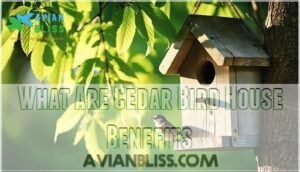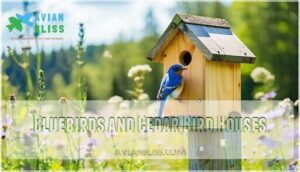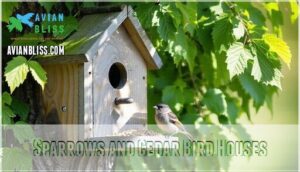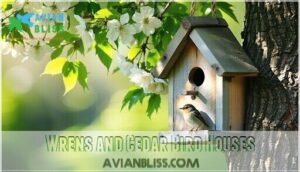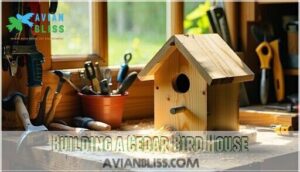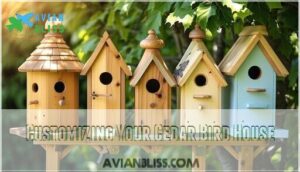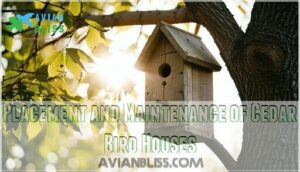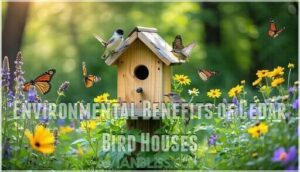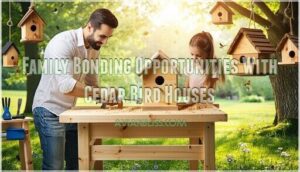This site is supported by our readers. We may earn a commission, at no cost to you, if you purchase through links.

You’ll love how cedar naturally repels insects and resists weather damage, meaning your feathered friends stay safe while you save money on replacements.
Cedar’s natural oils create a pest-free environment that birds prefer, and the wood doesn’t warp or crack like cheaper alternatives.
It’s also incredibly easy to work with using basic tools, making it perfect for weekend DIY projects.
The lightweight yet durable material attracts various species, from bluebirds to wrens, while requiring minimal maintenance.
There’s more to discover about maximizing your cedar birdhouse’s potential and how cedar can enhance your backyard experience.
Table Of Contents
- Key Takeaways
- Benefits of Cedar Bird Houses
- What Are Cedar Bird House Benefits
- Types of Birds Attracted to Cedar Houses
- Designing and Building Cedar Bird Houses
- Placement and Maintenance of Cedar Bird Houses
- Environmental Benefits of Cedar Bird Houses
- Cost-Effectiveness of Cedar Bird Houses
- Family Bonding Opportunities With Cedar Bird Houses
- Extending The Life of Your Cedar Bird House
- Frequently Asked Questions (FAQs)
- What are the benefits of a birdhouse?
- Is cedar a good wood for a birdhouse?
- Can you build a birdhouse with cedar fence pickets?
- What are the pros and cons of a birdhouse?
- Are birdhouses good for birds?
- Why is wood used in birdhouse construction important?
- Is cedar good for a bird house?
- What birds like cedar birdhouses?
- How long will a cedar birdhouse last?
- What wood is best for a bird house?
- Conclusion
Key Takeaways
- You’ll save money long-term because cedar’s natural oils repel insects and resist rot, eliminating the need for chemical treatments and frequent replacements that plague cheaper birdhouse materials.
- You’ll attract diverse bird species like bluebirds, robins, sparrows, and wrens since cedar provides superior insulation that keeps birds comfortable in both winter and summer while offering a pest-free nesting environment.
- You’ll enjoy minimal maintenance requirements because cedar’s weather-resistant properties mean you only need to clean twice yearly and perform basic inspections, unlike other materials that demand constant upkeep.
- You’ll contribute to environmental conservation while creating family bonding opportunities through DIY building projects that teach construction skills and provide ongoing birdwatching education for all ages.
Benefits of Cedar Bird Houses
Cedar birdhouses aren’t just practical; they’re a game-changer for birds and your yard.
Thanks to cedar wood’s natural insulation and pest resistance, these birdhouses provide a cozy, chemical-free haven that keeps birds safe from extreme weather and pesky insects.
Think of it as a custom-built hotel for your feathered friends.
A five-star retreat where birds check in for comfort and check out refreshed.
One of cedar’s standout benefits is its durability – it shrugs off rot, resists decay, and holds up against the elements, making it a truly long-lasting choice.
Plus, cedar’s lightweight design makes it easy to hang or mount, even in tricky spaces.
The aesthetic appeal of cedar is undeniable, with its rich hues effortlessly blending into outdoor landscapes, adding a touch of rustic charm to any garden.
Best of all, it’s a sustainable choice, minimizing environmental impact while promoting eco-friendly practices.
With cedar birdhouses, you’re combining function, beauty, and longevity perfectly.
What Are Cedar Bird House Benefits
In the context of birdhouse benefits, using cedar wood is like hitting the jackpot.
Cedar birdhouses are nature’s perfect match—durable, beautiful, and birds absolutely love them.
First, it’s tough as nails—thanks to its natural oils, cedar creates a durable birdhouse that shrugs off rot, insects, and harsh weather.
You won’t need constant repairs or replacements.
Then there’s its natural pest repellent scent, a handy bonus to keep your feathered guests safe.
Plus, cedar birdhouses are a sustainable choice, offering superior insulation.
They keep birds cozy in winter and cool in summer, mimicking nature’s balance.
Their lightweight design also makes hanging or mounting easy, even for beginners.
And let’s not forget the aesthetic appeal—rich colors and rustic charm blend seamlessly into any yard.
Functional, stylish, and eco-friendly—what’s not to love?
Types of Birds Attracted to Cedar Houses
Cedar bird houses attract a variety of species, including bluebirds, robins, sparrows, and wrens, thanks to their durable, weather-resistant design.
By choosing cedar, you’re providing a safe, natural space that meets birds’ nesting preferences while supporting their survival and breeding.
Bluebirds and Cedar Bird Houses
Bluebirds love cedar birdhouses thanks to their natural durability and safe nesting space.
To attract bluebirds, focus on these essentials:
| Factor | Best Choice |
|---|---|
| Wood Type | Western Red Cedar |
| Entrance Hole Size | 1.5 inches |
| House Dimensions | 5x5x10 inches |
| Mounting Height | At least 5 feet |
- Verify proper ventilation and drainage.
- Use a predator baffle design.
- Choose untreated cedar for health-friendly nesting.
- Place the birdhouse in open, sunny spots.
- Maintain annually for lasting birdhouse benefits.
Robins and Cedar Bird Houses
Robins, known for their unique nesting habits, favor cedar birdhouses placed near worm-rich soil for easy feeding.
Cedar’s natural properties repel insects, keeping their nests safe and snug.
For ideal robin safety, mount the birdhouse in open spaces, away from predators, while offering robins a durable, cozy home by choosing cedar wood, you’re enhancing your yard’s charm with this beloved bird species.
Sparrows and Cedar Bird Houses
Sparrows, tiny but fascinating birds, love cedar birdhouses with thoughtful designs.
They’re big fans of small spaces, so make sure the entrance size is about 1 inch—it’s like picking the perfect lock for them. Location matters too. Place the birdhouse 6-10 feet above ground in a sheltered spot.
Here’s a quick guide to sparrow-friendly designs:
- Design with shelter-favoring sparrow nesting habits in mind.
- Use durable cedar for sparrow safety and protection from predators.
- Provide proper ventilation to keep nesting birds comfy.
- Clean annually; sparrows often reuse nests.
- Offer nearby feeders for happy little visitors!
Wrens and Cedar Bird Houses
Wrens, as lively and chatty nesting birds, are easily attracted to a cedar birdhouse suited to their needs.
Focus on a Wren-Specific Design with an Entrance Hole Diameter of no more than 1.25 inches.
Place it 5–10 feet up, mimicking their preferred Placement Height.
For their Wren Nesting Habits, offer a cozy space with twigs and leaves, ensuring your birdhouse design feels like home.
Designing and Building Cedar Bird Houses
Building a cedar bird house lets you create a durable, eco-friendly home that birds will love.
By choosing high-quality cedar and following basic construction steps, you’ll guarantee a safe and inviting space for your feathered visitors, which will be a durable addition to your yard.
Choosing The Right Cedar Wood
Choosing cedar wood for a birdhouse is like picking the right shoes—fit matters.
Go for Western red cedar, known for natural resistance to rot, insects, and bad weather.
Look for clear or tight knot grades for durability and charm.
Prioritize sustainable harvesting to protect forests.
You can find a cedar wood birdhouse for various bird species.
With excellent grain orientation and density, cedar birdhouses promise safety, style, and eco-friendly nesting.
Building a Cedar Bird House
Building a cedar birdhouse is easier than you think! Start by selecting durable, weather-resistant cedar wood for its natural insect repellent properties.
You can easily find cedar birdhouse wood online for your project.
Here’s your blueprint:
- Gather tool essentials—saw, hammer, nails.
- Cut and sand the cedar carefully, ensuring smooth edges.
- Assemble with secure joint construction for stability, keeping the design simple yet effective.
Good craftsmanship lasts decades!
Customizing Your Cedar Bird House
Customizing your cedar birdhouse is simple and rewarding. Focus on key features like entrance size, roof styles, and paint choices to match bird preferences and yard aesthetics.
Consider drainage solutions and sturdy mounting options to guarantee durability. Personal touches also make it stand out.
| Customization Feature | Why It Matters | Tip for Success |
|---|---|---|
| Entrance Size | Fits specific bird species | Match hole size to target birds |
| Roof Styles | Shields from harsh weather | Use slanted, waterproof designs |
| Paint Choices | Adds visual appeal | Stick to bird-safe paints |
| Drainage Solutions | Prevents water buildup | Drill small bottom holes |
Blend function and creativity for a standout birdhouse, and remember to use sturdy mounting options to ensure it lasts, with a good roof style to shield from harsh weather.
Placement and Maintenance of Cedar Bird Houses
Placing your cedar bird house correctly guarantees birds feel safe and comfortable, while proper maintenance keeps it inviting for years.
By following simple cleaning routines and location tips, you’ll create a welcoming space that contributes to bird health and happiness, ensuring that birds feel safe.
Where to Place Your Cedar Bird House
Place your cedar birdhouse at least five feet high for predator avoidance.
Choose a birdhouse location with partial sun exposure and nearby shade to keep birds comfortable.
Mount on a tree, pole, or sturdy wall, guaranteeing it mimics natural habitat.
Keep it away from busy spots, offering peace for nesting, and guarantee weather protection to maximize birdhouse benefits for birds.
How to Clean and Maintain Your Bird House
A well-kept cedar birdhouse lasts longer and keeps birds healthier. Regular inspections and seasonal cleaning are key.
Clean your birdhouse twice a year—early spring before nesting season and late fall after the birds leave. Use safe cleaners like mild soap or a vinegar solution, scrubbing gently to remove debris. Consider using a specialized cedar birdhouse cleaner for superior results.
Inspect for pests, repair any damage, and make certain it’s completely dry before reassembly. Proper maintenance keeps your birdhouse cozy and inviting.
- Protect your birds: Remove pests and old nests.
- Extend its life: Catch small issues early.
- Keep it safe: Fix cracks or gaps.
- Encourage re-nesting: Provide a clean, fresh home.
Tips for Attracting Birds to Your Yard
- Hang your cedar birdhouse in safe, shaded spots, 5–10 feet high.
- Surround it with native plants for food and natural shelter options birds love.
- Offer a water feature like a birdbath—think “bird spa.”
- Keep predators away with thorny shrubs or proper birdhouse placement, ensuring a hassle-free bird habitat. Reliable bird feeders seal your yard’s avian invitation.
Environmental Benefits of Cedar Bird Houses
Using cedar bird houses helps you protect the planet by reducing waste and chemical use, thanks to cedar’s natural resistance to insects and rot.
Plus, by offering a safe nesting spot for birds, you’re supporting local ecosystems and promoting biodiversity right in your backyard.
Promoting Ecological Balance
A cedar birdhouse isn’t just a cozy spot for birds; it’s a small step toward habitat preservation and ecological balance.
By encouraging birds into your yard, you’re supporting biodiversity and natural ecosystem support, including pest control and seed dispersion.
Cedar’s sustainable materials and natural properties reduce chemicals, keeping the environment healthier.
Plus, these birdhouses promote species diversity, giving birds a safe home while enhancing your local ecosystems, making your backyard a buzzing, eco-friendly sanctuary!
Providing a Safe Haven for Birds
Cedar birdhouses create the perfect bird shelter, combining Predator Protection and Weather Resistance with a natural charm.
They mimic birds’ habitats, ensuring nesting safety with features like secure entrances and durable materials.
These cozy shelters offer:
- Reliable bird safety from harsh weather
- Smart designs to deter predators
- Comfortable nesting spots for bird health
- Humidity control through cedar oils
- Consistent temperature regulation
Supporting Local Bird Populations
Providing safe spaces supports bird populations while protecting avian habitats.
A cedar birdhouse benefits local bird populations by offering sturdy shelters that reduce predator risks.
Pair it with native plants and water sources for an inviting habitat.
Predator control and good design keep birds thriving, leading to better bird conservation.
Bird feeders and proper placement guarantee safety and comfort.
Think of it as preserving nature’s orchestra—each birdhouse a stage where local bird populations flourish, contributing to habitat preservation and biodiversity.
Providing these elements ensures that the birdhouses serve as effective tools for bird conservation.
Cost-Effectiveness of Cedar Bird Houses
You’ll find cedar bird houses are a smart investment because they’re built to last, saving you money on replacements.
Their natural durability and low maintenance needs make them a cost-effective choice for any bird lover.
Budget-Friendly DIY Project
Transforming cedar wood into a birdhouse is a satisfying and budget-friendly DIY project.
With low-cost materials and simple plans, you can enjoy nature without breaking the bank.
Plus, with tools at home and upcycled materials, creating a cedar birdhouse becomes even more rewarding.
- Save money by using cost-cutting design simplicity.
- Reuse scraps for an eco-friendly twist.
- Empower creativity with customization.
- Source materials easily from local stores.
- Skip chemicals thanks to cedar’s natural insect resistance.
Why buy when you can craft your own feathered paradise?
Long-Lasting and Durable
Building a cedar birdhouse isn’t just about creating a bird haven—it’s about crafting a long-lasting, weather-resistant home that stands strong over time.
Cedar’s natural oils act as built-in insect repellents, while its exceptional rot resistance guarantees minimal upkeep. Plus, you’ll love its structural integrity, even in tough climates. Forget frequent repairs!
- Natural benefits: Cedar repels insects and resists decay.
- Longevity: Holds up in extreme weather.
- Durability: Strong against wear and tear.
- Easy maintenance: No added chemicals needed.
- Cost-effective: Long-term value without hassle.
Low Maintenance Costs
You’ll love how low maintenance a cedar birdhouse is.
The natural durability of cedar wood means less upkeep, thanks to its pest repellency and weather resistance.
Forget constant repairs—this cost-effective option saves money while offering a long lifespan.
With simple seasonal cleanings, your birdhouse stays strong and inviting, making it an effortless addition to your yard.
Family Bonding Opportunities With Cedar Bird Houses
Building a cedar bird house with your family creates meaningful memories while teaching valuable construction skills, patience, and teamwork through hands-on collaboration.
You’ll discover that watching birds together becomes an ongoing educational experience, as family members learn to identify species, observe nesting behaviors, and develop a deeper appreciation for wildlife conservation.
Building a Bird House Together
Gather around the workbench with your loved ones—cedar birdhouse construction creates unforgettable Family Fun while teaching valuable skills.
This DIY project transforms raw cedar lumber into something special, fostering family bonding through Shared Creativity and hands-on Skill Development that’ll stick with everyone for years.
- Outdoor Learning happens naturally as kids discover woodworking basics and wildlife habitat needs
- Lasting Memories form when families work together, sharing laughs over crooked cuts and celebrating successes
- Birdhouse plans become teaching tools, showing children how to follow directions and problem-solve creatively
- Family bonding strengthens through shared accomplishment, creating traditions that span generations of builders
Observing and Learning About Birds
Your cedar birdhouse becomes a front-row seat for birdwatching basics and species identification.
Watch families learn bird behavior firsthand—from territorial displays to feeding routines.
Document nesting habits throughout seasons, noting which local bird populations return annually.
Track migration patterns as different species arrive and depart, turning your backyard into a living classroom for bird watching enthusiasts.
Creating a Fun and Educational Experience
Your cedar birdhouse transforms into a living classroom where family bonding opportunities flourish naturally.
Birdwatching basics become exciting lessons as you observe bird behavior together, creating educational customization moments.
These family projects foster nature observation skills while discovering backyard biodiversity.
Bird watching sessions spark curiosity about wildlife education, turning ordinary afternoons into memorable adventures that strengthen family connections through shared discovery.
Extending The Life of Your Cedar Bird House
You’ve invested in a quality cedar bird house, and with proper care, it can provide a safe nesting haven for decades while maintaining its natural beauty.
Simple maintenance routines, including regular inspections and seasonal cleaning, will maximize your cedar house’s lifespan and guarantee it continues attracting birds year after year, which is a key factor in ensuring the house remains a safe haven.
Regular Inspections and Repairs
Your cedar birdhouse needs regular check-ups to stay bird-ready.
Monthly regular inspections help catch problems early, from loose screws to weather damage. Damage assessment should include checking for cracks, warped wood, or pest infiltration.
Structural integrity matters most—wobbly houses won’t attract tenants. Pest control means removing wasp nests or ant trails. Weatherproofing touchups protect against rain damage.
Repair frequency depends on your climate, but spring and fall birdhouse maintenance keeps everything solid. Birdhouse repairs and birdhouse durability go hand-in-hand with consistent care.
Seasonal Preparations and Cleaning
Throughout each season, your cedar birdhouse needs specific care to thrive like a well-tended garden.
Here’s your seasonal maintenance checklist:
- Spring cleaning removes old nests and debris while checking for winter damage
- Summer inspections focus on pest control and ventilation adjustments
- Winter protection involves sealing gaps and ensuring proper drainage before harsh weather
Regular birdhouse maintenance keeps feathered friends returning year after year.
Tips for a Long-Lasting Bird House
Building on your seasonal cleaning routine, here’s how to maximize your cedar birdhouse’s lifespan.
Quality materials like cedar naturally resist weather, but smart design choices make the difference between a house lasting five years versus fifteen.
| Feature | Benefit |
|---|---|
| Proper Drainage | Prevents water damage and mold growth |
| Predator Guards | Protects nesting birds from threats |
| Ventilation Needs | Maintains healthy air circulation |
| Secure Mounting | Withstands storms and wind damage |
| Weather Resistant Coating | Extends wood life and appearance |
Your cedar birdhouse becomes truly long lasting when you combine preventative maintenance with these design elements, ensuring birdhouse durability for generations of feathered friends, with features like proper drainage and secure mounting.
Frequently Asked Questions (FAQs)
What are the benefits of a birdhouse?
Good things come to those who wait" rings true with birdhouses.
You’ll provide safe nesting sites, protect birds from predators and harsh weather, support breeding success, and attract diverse species that enhance your garden’s natural ecosystem.
This will support breeding success, and attract diverse species.
Is cedar a good wood for a birdhouse?
You’ll find cedar’s an excellent choice for birdhouses.
Its natural oils repel insects and resist rot, while providing superior insulation for nesting birds.
Plus, it’s lightweight, easy to work with, and environmentally friendly.
Can you build a birdhouse with cedar fence pickets?
You can absolutely build a birdhouse with cedar fence pickets!
They’re perfect for the job since cedar naturally repels insects and resists rot, making your DIY project both budget-friendly and long-lasting.
What are the pros and cons of a birdhouse?
Like a two-sided coin, birdhouses offer clear advantages and drawbacks.
You’ll attract diverse wildlife, support conservation, and enjoy natural pest control.
However, you’ll face maintenance demands, potential predator issues, and seasonal cleaning requirements.
Are birdhouses good for birds?
Birdhouses absolutely benefit birds by providing safe nesting sites, protection from predators and harsh weather, and secure spaces for raising young.
They’re especially valuable when natural cavity sites are scarce in your area, making birdhouses a crucial protection.
Why is wood used in birdhouse construction important?
Ever wonder why your feathered friends seem picky about their homes?
Wood choice dramatically affects durability, insulation, and safety.
Cedar’s natural oils repel insects, resist rot, and regulate temperature, creating the perfect sanctuary for successful nesting.
Is cedar good for a bird house?
Cedar’s your best bet for birdhouses.
Its natural oils repel insects and resist rot, while providing excellent insulation for nesting birds.
You’ll get years of durability without chemical treatments, making it perfect for eco-friendly bird lovers, with cedar providing a natural solution that is both durable and resist rot.
What birds like cedar birdhouses?
You’ll attract bluebirds, robins, sparrows, and wrens to cedar birdhouses since they’re naturally drawn to the wood’s durability and pest-resistant properties. These species appreciate cedar’s insulation and safe nesting environment.
How long will a cedar birdhouse last?
You’ll get decades of reliable use from your cedar birdhouse thanks to its natural oils that repel insects and resist rot.
With minimal maintenance, it’ll outlast cheaper alternatives by years while keeping birds safe and comfortable.
What wood is best for a bird house?
While you might think any wood works, cedar’s your best bet for birdhouses.
It naturally repels insects, resists rot, and provides excellent insulation.
You’ll get years of use without chemical treatments or constant maintenance.
Conclusion
Cedar bird houses are like investment portfolios for your backyard—they deliver returns year after year.
The cedar bird house benefits you’ve discovered make this choice a clear winner for attracting diverse bird species while protecting your wallet.
You’ll enjoy watching feathered visitors flock to their pest-free, weatherproof homes, knowing you’ve made an environmentally conscious decision.
With minimal maintenance required and decades of durability ahead, your cedar bird house will continue bringing nature’s symphony to your doorstep.
- https://www.thespruce.com/free-birdhouse-plans-1357100
- https://kidadl.com/facts/cedar-wood-facts-uses-characteristics-disadvantages-and-more
- https://www.maximumyield.com/definition/2954/hardwood
- https://marketing.avofenceandsupply.com/blog/exploring-the-types-and-grades-of-cedar
- https://greenmainehomes.com/blog/choosing-the-right-cedar-for-your-project

